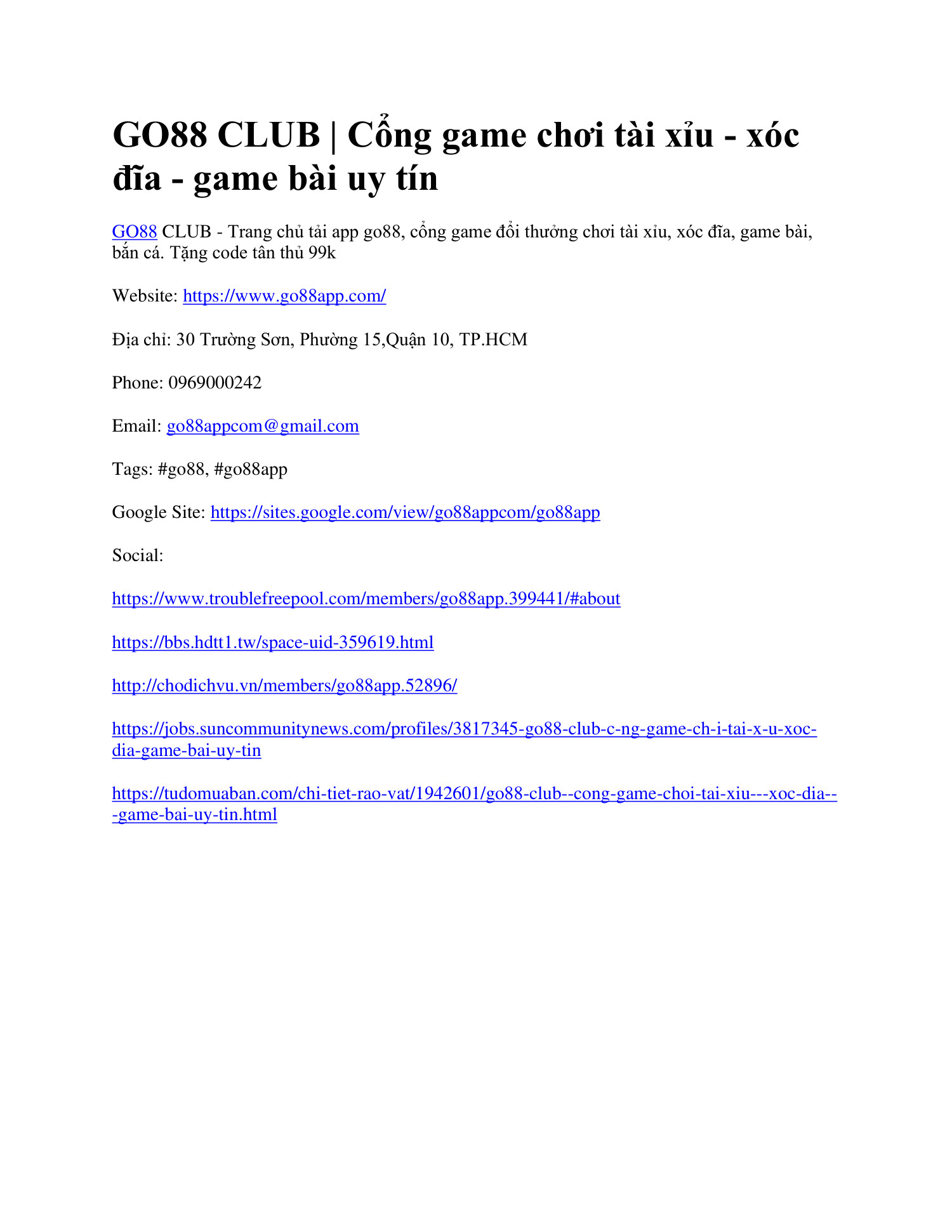go88 – Nơi Tạo Ra Những Phần Thưởng Đáng Giá! Đây là câu slogan mà bất kỳ ai yêu thích trò chơi trực tuyến cũng đều biết đến. Với một nền tảng vững mạnh, GO88 không chỉ mang đến những giây phút giải trí thú vị mà còn làm cho người chơi cảm thấy hài lòng với các phần thưởng hấp dẫn từ những trò chơi đa dạng và phong phú. Trong bài viết này, chúng ta sẽ đi sâu vào từng khía cạnh của GO88 để khám phá lý do tại sao nó lại trở thành một trong những lựa chọn hàng đầu cho người chơi trực tuyến.
GO88 – Nền Tảng Giải Trí Hàng Đầu với Phần Thưởng Hấp Dẫn
GO88 không chỉ là một nền tảng chơi game thông thường mà còn là một hệ sinh thái tích hợp nhiều yếu tố quan trọng như sự sáng tạo, tính bảo mật và trải nghiệm người dùng tuyệt vời.
Lịch Sử Hình Thành và Phát Triển của GO88
Nhìn về nguồn gốc của GO88, ta có thể thấy rằng đây là một dự án được hình thành với mục tiêu cung cấp một môi trường chơi game an toàn và công bằng. Ngay từ những ngày đầu, đội ngũ sáng lập đã chú trọng đến việc xây dựng một nền tảng không chỉ thu hút người chơi mà còn đảm bảo tính minh bạch trong mọi giao dịch.
Điều này được thể hiện qua việc áp dụng công nghệ tiên tiến nhất để bảo vệ tài khoản người chơi và dữ liệu cá nhân của họ, giúp người chơi yên tâm hơn khi tham gia vào các hoạt động giải trí tại đây.
Đặc Điểm Nổi Bật Của GO88
Một điểm nổi bật của GO88 là sự đa dạng trong các loại trò chơi. Từ những trò chơi thẻ bài quen thuộc như Poker, Blackjack đến những trò chơi điện tử hiện đại như slot game và live casino, tất cả đều được thiết kế tinh tế để mang đến trải nghiệm tốt nhất cho người dùng.
Ngoài ra, GO88 cũng thường xuyên cập nhật các trò chơi mới, giúp người chơi không bao giờ cảm thấy nhàm chán. Các phần thưởng cũng được thiết kế đa dạng, từ tiền mặt đến các món quà giá trị khác, tạo động lực cho người chơi tiếp tục khám phá.
Tại Sao GO88 Trở Thành Lựa Chọn Hàng Đầu?
Nhiều người chơi trên thị trường nhận định rằng GO88 không chỉ đơn thuần là một nơi để giải trí mà còn là một cơ hội để kiếm tiền. Chính những phần thưởng hấp dẫn cùng với sự công bằng trong cách thức vận hành đã góp phần tạo nên danh tiếng cho GO88.
Hơn nữa, thái độ phục vụ khách hàng tận tình và chuyên nghiệp cũng là yếu tố không thể thiếu. Đội ngũ hỗ trợ luôn sẵn sàng giải đáp mọi thắc mắc và tư vấn cho người chơi để họ có thể đạt được tối đa lợi ích từ việc tham gia.
Khám Phá Kho Tàng Phần Thưởng Khổng Lồ tại GO88
Kho tàng phần thưởng tại GO88 thực sự rất phong phú và đa dạng, với nhiều ưu đãi hấp dẫn dành cho người chơi.
Những Loại Phần Thưởng Có Tại GO88
Tại GO88, người chơi có thể dễ dàng tìm thấy nhiều loại phần thưởng khác nhau như:
- Tiền thưởng nạp đầu: Đây là một trong những hình thức khuyến mãi phổ biến mà GO88 cung cấp cho người chơi mới. Khi lần đầu tiên nạp tiền vào tài khoản, bạn sẽ nhận được một phần trăm nhất định từ số tiền nạp ban đầu.
- Phần thưởng tham gia: Người chơi có thể nhận được phần thưởng khi tham gia vào các trò chơi hay sự kiện đặc biệt. Điều này không chỉ kích thích người chơi tham gia mà còn tạo ra cơ hội để họ nhận thêm nhiều phần thưởng giá trị.
- Quà tặng theo sự kiện: GO88 thường tổ chức các sự kiện lễ hội hoặc kỷ niệm, nơi mà người chơi có cơ hội nhận những phần quà hấp dẫn như chuyến du lịch, sản phẩm điện tử hay thậm chí là xe hơi.
Tính Chất Đặc Biệt Của Các Phần Thưởng
Mỗi phần thưởng tại GO88 không chỉ đơn giản là một món quà vật chất. Nó còn mang lại cho người chơi cảm giác hưng phấn và hồi hộp khi tham gia. Với mỗi lần quay thưởng hay nhận thưởng, người chơi lại được trải nghiệm những cung bậc cảm xúc khác nhau, tạo nên sự thú vị trong quá trình chơi.
Đặc biệt, GO88 không giới hạn số lượng phần thưởng mà người chơi có thể nhận được. Điều này đồng nghĩa với việc bạn càng chơi nhiều thì cơ hội nhận thưởng càng lớn, tạo động lực cho người chơi cống hiến nhiều hơn trong các trò chơi.
Cách Nhận Phần Thưởng Tại GO88
Để nhận phần thưởng tại GO88, người chơi cần phải thực hiện một số bước đơn giản. Đầu tiên, bạn cần đăng ký tài khoản trên nền tảng GO88. Sau đó, thực hiện nạp tiền vào tài khoản của mình để đủ điều kiện nhận phần thưởng. Cuối cùng, tham gia vào các trò chơi mà bạn yêu thích để có cơ hội nhận thưởng.
Ngoài ra, GO88 còn cung cấp một hướng dẫn chi tiết về cách thức nhận thưởng để giúp người chơi dễ dàng tiếp cận và tận hưởng các ưu đãi.
Những Phần Thưởng Đáng Giá Chỉ Có Tại GO88
GO88 không chỉ đem đến những phần thưởng hấp dẫn mà còn là những phần thưởng độc quyền mà bạn khó có thể tìm thấy ở nơi khác.
Phần Thưởng Độc Quyền Cho Người Chơi VIP
Chương trình VIP tại GO88 được thiết kế đặc biệt dành cho những người chơi thường xuyên và trung thành. Những người chơi thuộc nhóm VIP sẽ được hưởng nhiều đặc quyền như:
- Tăng tỷ lệ hoàn tiền: Người chơi VIP có thể nhận được tỷ lệ hoàn tiền cao hơn so với các thành viên thông thường. Điều này có nghĩa là bạn sẽ nhận lại một phần tiền cược của mình sau mỗi vòng chơi.
- Dịch vụ chăm sóc khách hàng chuyên nghiệp: Các thành viên VIP sẽ có một đội ngũ chăm sóc khách hàng riêng biệt, sẵn sàng hỗ trợ và tư vấn mọi lúc mọi nơi.
- Cơ hội tham gia các sự kiện đặc biệt: GO88 thường xuyên tổ chức các sự kiện riêng cho thành viên VIP, nơi họ có cơ hội nhận những phần thưởng lớn và trải nghiệm các trò chơi độc quyền.
Phần Thưởng Hấp Dẫn Từ Các Trò Chơi
Từng trò chơi tại GO88 đều có những phần thưởng đặc trưng riêng. Ví dụ như trong các trò chơi slot, người chơi có thể nhận được jackpot cực lớn nếu may mắn. Hay trong các trò chơi bài, thắng lớn từ một ván bài có thể mang lại cho bạn một khoản tiền không nhỏ.
Sự hấp dẫn của các phần thưởng này không chỉ nằm ở giá trị vật chất mà còn ở cảm giác thỏa mãn khi bạn vượt qua thử thách và đạt được thành công trong trò chơi.
Cảm Nhận Của Người Chơi Về Các Phần Thưởng
Người chơi tại GO88 thường chia sẻ những trải nghiệm tích cực về các phần thưởng mà họ đã nhận được. Họ không chỉ vui vẻ với giá trị của phần thưởng mà còn đánh giá cao quy trình nhận thưởng nhanh chóng và dễ dàng.
Điều này tạo ra một cộng đồng người chơi thân thiện và gắn kết, nơi mà mọi người đều có chung đam mê với trò chơi và hy vọng nhận được phần thưởng giá trị.
Hướng Dẫn Nhận Phần Thưởng và Khuyến Mãi tại GO88
Để có thể nhận được những phần thưởng và khuyến mãi tại GO88, người chơi cần nắm rõ cách thức và những điều kiện cần thiết.
Giao Diện Đăng Ký và Tham Gia Khuyến Mãi
Đầu tiên, bạn cần truy cập vào trang chủ của GO88 và tiến hành đăng ký tài khoản. Giao diện người dùng tại GO88 rất thân thiện và dễ sử dụng, giúp người chơi mới có thể nhanh chóng thực hiện các bước cần thiết mà không gặp khó khăn gì.
Sau khi đăng ký thành công, người chơi cũng nên kiểm tra mục khuyến mãi trên trang chủ để nhận diện các chương trình đang diễn ra. Các thông tin chi tiết về cách thức tham gia cũng như thời gian áp dụng cho từng khuyến mãi đều được cung cấp rõ ràng.
Thực Hiện Cách Nhận Phần Thưởng
Khi bạn đã nạp tiền vào tài khoản và tham gia các trò chơi, hãy lưu ý đến cách thức nhận phần thưởng. Có những phần thưởng sẽ tự động được ghi có vào tài khoản của bạn ngay sau khi bạn thực hiện các điều kiện cần thiết.
Tuy nhiên, cũng có những chương trình khuyến mãi yêu cầu bạn phải nhập mã khuyến mãi trước khi thực hiện nạp tiền hoặc tham gia trò chơi. Đừng quên xem xét kỹ lưỡng các thông tin này để không bỏ lỡ cơ hội nhận thưởng.
Theo Dõi Lịch Trình Khuyến Mãi
GO88 thường xuyên tổ chức nhiều chương trình khuyến mãi và sự kiện hấp dẫn. Bạn nên theo dõi các thông báo từ GO88 qua email hoặc trang mạng xã hội để không bỏ lỡ những cơ hội nhận thưởng lớn.
Ngoài ra, việc tham gia các diễn đàn hoặc nhóm cộng đồng người chơi cũng giúp bạn cập nhật nhanh chóng các thông tin mới nhất về phần thưởng và khuyến mãi.
Chương Trình Khuyến Mãi Đa Dạng, Thu Hút Người Chơi tại GO88
Không giống như nhiều nền tảng khác, GO88 luôn đổi mới và cải tiến chương trình khuyến mãi của mình nhằm mục tiêu thu hút và giữ chân người chơi.
Các Chương Trình Khuyến Mãi Liên Tục
GO88 triển khai nhiều chương trình khuyến mãi liên tục dành cho cả người chơi mới và người chơi cũ. Một trong những chương trình nổi bật là “Khuyến Mãi Tháng” với nhiều phần thưởng giá trị được trao cho người chơi tham gia trong tháng đó.
Ngoài ra, các sự kiện theo mùa như Tết Nguyên Đán, Giáng Sinh cũng thường được tổ chức, mang đến không khí lễ hội và những cơ hội nhận thưởng cực lớn cho người chơi.
Sự Độc Đáo Trong Các Chương Trình Khuyến Mãi
Điểm đáng chú ý trong các chương trình khuyến mãi của GO88 chính là tính độc đáo. Không chỉ dừng lại ở các phần thưởng tiền mặt, GO88 còn mang đến những cuộc thi và giải đấu hấp dẫn, nơi người chơi có thể thể hiện kỹ năng và khả năng của mình để nhận được những phần thưởng giá trị.
Đồng thời, GO88 cũng thường xuyên phối hợp với các đối tác để đưa ra những chương trình khuyến mãi hấp dẫn hơn, giúp người chơi có thêm nhiều lựa chọn và cơ hội nhận thưởng.
Cách Tối Ưu Hóa Lợi Ích Từ Các Chương Trình Khuyến Mãi
Để tối ưu hóa lợi ích từ các chương trình khuyến mãi, người chơi nên lên kế hoạch tham gia. Việc theo dõi lịch trình và các điều kiện tham gia sẽ giúp bạn không bỏ lỡ những cơ hội vàng để nhận thưởng.
Bạn cũng có thể tham gia vào các nhóm cộng đồng để trao đổi kinh nghiệm và thông tin về các chương trình khuyến mãi đang diễn ra. Điều này không chỉ giúp bạn tiết kiệm thời gian mà còn tăng khả năng nhận thưởng.
Trải Nghiệm Trò Chơi Hấp Dẫn và Nhận Phần Thưởng Giá Trị
Khi nói đến GO88, không thể không nhắc đến trải nghiệm tuyệt vời mà người chơi có được khi tham gia các trò chơi tại đây.
Độ Đa Dạng Trong Các Trò Chơi
GO88 cung cấp một kho tàng trò chơi đa dạng từ truyền thống đến hiện đại. Người chơi có thể tìm thấy những trò chơi như Baccarat, Roulette cho đến những slot game mới nhất với đồ họa sắc nét và âm thanh sống động.
Các trò chơi không chỉ đơn thuần là giải trí mà còn là cơ hội để người chơi thể hiện kỹ năng và chiến lược của mình. Do đó, mỗi người chơi đều có thể tìm thấy trò chơi phù hợp với sở thích của mình.
Trải Nghiệm Người Chơi Đỉnh Cao
Hệ thống của GO88 được thiết kế để mang lại trải nghiệm người chơi tốt nhất, từ giao diện thân thiện cho đến tốc độ tải trang nhanh.
Hơn nữa, các trò chơi đều được phát triển bởi những nhà cung cấp uy tín và có thương hiệu, đảm bảo chất lượng và tính công bằng. Chính nhờ vậy, người chơi có thể hoàn toàn yên tâm khi tham gia vào các trò chơi tại GO88.
Chiến Lược Nhận Thưởng Hiệu Quả
Để có thể nhận thưởng từ các trò chơi, người chơi cần phát triển một chiến lược chơi hợp lý. Hãy luôn theo dõi các thông tin khuyến mãi và phần thưởng có sẵn để tận dụng tối đa lợi ích từ việc chơi game.
Ngoài ra, việc đặt ra giới hạn chơi và quản lý ngân sách cũng rất quan trọng để đảm bảo trải nghiệm chơi game trở nên thú vị mà không bị áp lực tài chính.
GO88 – Nơi Tạo Ra Cơ Hội Thắng Lớn và Phần Thưởng Hấp Dẫn
Tại GO88, việc tới gần hơn với phần thưởng luôn được thực hiện một cách thông minh và đầy sáng tạo.
Cơ Hội Thắng Lớn Từ Các Trò Chơi
Nhiều người chơi đã từng chia sẻ rằng họ đã có những trải nghiệm thắng lớn tại GO88. Đó không chỉ là những khoản tiền mặt đơn thuần mà còn là sự mãn nguyện khi chứng kiến nỗ lực của mình được đền đáp.
Với các phần thưởng lớn từ các trò chơi jackpot hay các giải đấu, mỗi người chơi đều có cơ hội trở thành triệu phú chỉ sau một đêm.
Những Yếu Tố Ảnh Hưởng Đến Cơ Hội Thắng
Để tăng cơ hội thắng, người chơi cần nắm bắt các yếu tố ảnh hưởng như xác suất trò chơi, chiến thuật và phong cách chơi của bản thân.
Việc nghiên cứu và tìm hiểu các trò chơi cũng như chiến lược chơi là điều cần thiết để bạn có thể nâng cao khả năng thắng lớn tại GO88.
Cảm Nhận Của Người Chơi Về Cơ Hội Thắng
Rất nhiều người chơi đã có những phản hồi tích cực về cơ hội thắng lớn tại GO88. Họ cảm thấy hào hứng và mong muốn tiếp tục tham gia vào các trò chơi để trải nghiệm cảm giác hồi hộp và chờ đợi những phần thưởng giá trị.
Cách Thức Tham Gia và Nâng Cao Cơ Hội Nhận Phần Thưởng tại GO88
Để có thể tận dụng được tất cả những phần thưởng hấp dẫn mà GO88 mang lại, người chơi cần nắm rõ cách thức tham gia.
Đăng Ký Tài Khoản
Bước đầu tiên để tham gia vào GO88 là đăng ký tài khoản. Quá trình này rất đơn giản và nhanh chóng. Bạn chỉ cần cung cấp thông tin cá nhân cần thiết và xác minh tài khoản để bắt đầu hành trình nhận thưởng.
Nạp Tiền và Tham Gia Trò Chơi
Sau khi tài khoản đã được kích hoạt thành công, bạn cần thực hiện nạp tiền vào tài khoản của mình. GO88 hỗ trợ nhiều phương thức nạp tiền khác nhau như chuyển khoản ngân hàng, ví điện tử, thẻ cào…
Khi đã có tiền trong tài khoản, bạn có thể dễ dàng tham gia vào các trò chơi yêu thích và bắt đầu kiếm thưởng.
Theo Dõi Và Tham Gia Các Khuyến Mại
Để tối đa hóa lợi ích, bạn nên thường xuyên kiểm tra các chương trình khuyến mãi đang diễn ra trên GO88. Nắm bắt cơ hội này sẽ giúp bạn nhận được nhiều phần thưởng giá trị hơn.
Đảm Bảo An Toàn và Minh Bạch Khi Nhận Phần Thưởng tại GO88
An toàn và minh bạch là hai yếu tố rất quan trọng mà GO88 luôn cam kết thực hiện.
Chính Sách Bảo Mật
GO88 áp dụng các biện pháp bảo mật tiên tiến để bảo vệ thông tin cá nhân của người chơi. Tất cả dữ liệu đều được mã hóa và lưu trữ an toàn, giúp người chơi yên tâm khi tham gia vào các hoạt động giải trí.
Chính Sách Thanh Toán Minh Bạch
Mọi giao dịch tài chính trên GO88 đều được thực hiện một cách minh bạch. Người chơi có thể theo dõi lịch sử giao dịch của mình và nhận được thông báo ngay khi có bất kỳ thay đổi nào liên quan đến tài khoản.
GO88 luôn cam kết bảo đảm quyền lợi cho người chơi, đảm bảo mọi phần thưởng đều được phân phối công bằng và đúng hạn.
Hỗ Trợ Khách Hàng Tận Tình
Đội ngũ chăm sóc khách hàng của GO88 luôn sẵn sàng hỗ trợ người chơi 24/7. Mọi thắc mắc liên quan đến phần thưởng, giao dịch hay trò chơi đều được giải đáp nhanh chóng và hiệu quả.
Điều này giúp người chơi yên tâm hơn khi tham gia vào các trò chơi và nhận thưởng tại GO88.
GO88 – Sự Lựa Chọn Hoàn Hảo Cho Những Ai Yêu Thích Trò Chơi và Phần Thưởng
Nếu bạn đang tìm kiếm một nền tảng chơi game đáng tin cậy và hấp dẫn, GO88 chắc chắn là một sự lựa chọn tuyệt vời.
Đánh Giá Từ Người Chơi
Nhiều người chơi đã chia sẻ rằng GO88 là một trong những nền tảng giải trí trực tuyến tốt nhất mà họ từng trải nghiệm. Họ không chỉ ấn tượng với sự đa dạng trong các trò chơi mà còn với phần thưởng và dịch vụ chăm sóc khách hàng chu đáo.
Cộng Đồng Người Chơi Đông Đảo
Một trong những điểm mạnh của GO88 là cộng đồng người chơi rộng lớn. Bạn có thể dễ dàng kết nối, giao lưu và học hỏi kinh nghiệm từ những người chơi khác. Điều này không chỉ tạo ra một môi trường chơi game thân thiện mà còn giúp bạn nâng cao kỹ năng và chiến lược chơi của mình.
Cam Kết Từ GO88
GO88 cam kết mang đến cho người chơi những trải nghiệm tốt nhất với các trò chơi đa dạng, phần thưởng hấp dẫn và dịch vụ hỗ trợ tận tình. Họ luôn lắng nghe và cải tiến để đáp ứng nhu cầu của người chơi, giúp mỗi người đều cảm thấy hài lòng khi tham gia.
Kết luận
GO88 – Nơi Tạo Ra Những Phần Thưởng Đáng Giá! đã khẳng định vị thế của mình trong ngành công nghiệp giải trí trực tuyến. Với sự đa dạng trong các trò chơi, các phần thưởng hấp dẫn cùng với dịch vụ khách hàng tận tâm, GO88 thực sự là một địa chỉ đáng tin cậy cho những ai yêu thích sự mới mẻ và cơ hội nhận thưởng lớn.
Hy vọng bài viết này đã giúp bạn hiểu rõ hơn về GO88 và những gì mà nó mang lại. Nếu bạn đang tìm kiếm một sân chơi thú vị, đừng ngần ngại tham gia ngay hôm nay để trải nghiệm những điều tuyệt vời mà GO88 mang đến!


























